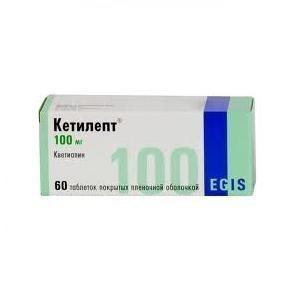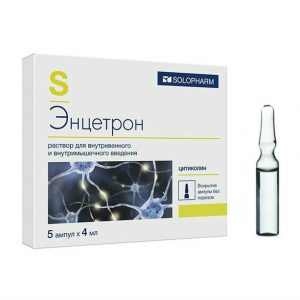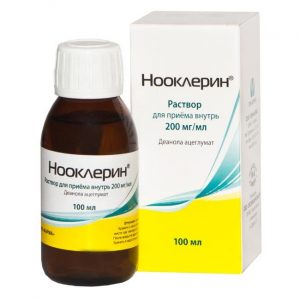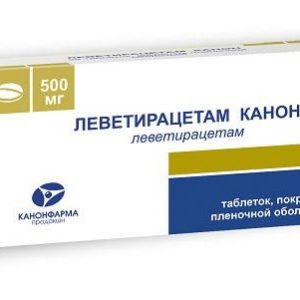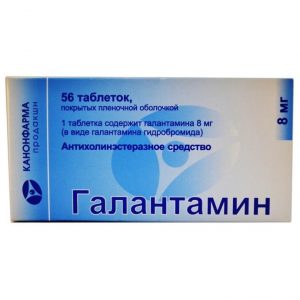Description
release form
Tablets film-coated
packaging 60 pcs
Indications
acute and chronic psychoses, including schizophrenia
treatment of manic episodes in the structure of bipolar disorder
treatment of depressive episodes of moderate to severe severity in the structure of bipolar disorder.
pregnancy and lactation
Category by effect on pregnancy – C.
Safety and effectiveness of the use of quetiapine during pregnancy have not been established. Ketilept should not be used during pregnancy, unless when the benefit to the mother outweighs the potential risk to the fetus.
Breast-feeding period: It is not known whether quetiapine is excreted in human milk. Therefore, lactating women are advised to abandon breastfeeding while taking Ketilept.
Composition
1 tablet contains: active substance: quetiapine 100 mg (as quetiapine fumarate)
excipients: microcrystalline cellulose, sodium lactose monohydrate, silico magnesium hydrate, dioxide, triacetin, macrogol, lactose monohydrate, titanium dioxide, hypromellose.
Dosage and administration of
Ketilept is taken orally, regardless of food intake, 2 times a day.
Adults. The total daily dose in the first 4 days of therapy is 50 mg (on the 1st day), 100 mg (on the 2nd day), 200 mg (on the 3rd day) and 300 mg (on the 4th day).
Starting on day 4, the usual effective daily dose of Ketilept is 300 mg. Depending on the clinical response and tolerance in each patient, the dose can be clarified in the range from 150 to 750 mg / day.
The safety of daily doses above 800 mg has not been evaluated in clinical studies.
Children and adolescents. The efficacy and safety of quetiapine in children and adolescents has not been established.
Renal and hepatic insufficiency. It is recommended to start therapy with 25 mg / day, then increase the dose by 25 50 mg daily until an effective dose is achieved, depending on the patient s clinical response and individual tolerance.
Side effects of
The most common side effects of quetiapine are drowsiness, dizziness, dry mouth, mild asthenia, constipation, tachycardia, orthostatic hypotension and dyspepsia. According to the total data of clinical studies, the number of patients who stopped taking the drug due to side effects is approximately the same in the groups receiving placebo and quetiapine.
As with other antipsychotics, quetiapine fainting, malignant antipsychotic syndrome, leukopenia, neutropenia, and peripheral edema are noted.
Adverse events observed with the administration of quetiapine and classified by the body systems are listed below in this order: very often -> 1/10 often – 1/100 infrequently – 1/1000 rarely – Blood and lymph system: often – leukopenia infrequently – eosinophilia very rarely – neutropenia 3.
Immune system disorders: infrequently – hypersensitivity.
Metabolism and nutrition: often – increase in body weight4, increase in serum transaminases (ALT, ACT) 5 very rarely – hyperglycemia1, diabetes1.7.
Disorders of the nervous system: very often – dizziness1.6, drowsiness2 often – headache, anxiety, psychomotor agitation, tremor, fainting1.6 infrequently – epileptic seizures1.
Dysfunctions of the heart: often – tachycardia 1.6.
Vascular disorders: often – orthostatic hypotension 1.6.
Respiratory and organ dysfunction of the chest cavity and mediastinum: often – rhinitis, pharyngitis.
Disorders of the digestive tract: often – dry mouth, constipation, diarrhea, dyspepsia, abdominal pain.
Dysfunctions of the reproductive organs and mammary glands: rarely – priapism.
General disorders and condition of tissues at the injection site: often – mild asthenia, peripheral edema rarely – malignant antipsychotic syndrome1.
Laboratory tests: infrequently – increased levels of gamma-glutamyltransferase (gamma-GT) 5, increased triglycerides after meals, increased total cholesterol.
Other: lower back pain, chest pain, low-grade fever, myalgia, dry skin, decreased visual acuity.
Drug Interaction
Caution is advised when prescribing Ketilept in combination with other CNS agents. The results of the in vitro study showed that quetiapine and 9 of its metabolites in vivo are weak inhibitors of metabolic processes mediated by isoenzymes of the cytochrome P450 system (1A2, 2C9, 2C19, 2D6 and 3A4). CYP3A4 is the major enzyme that mediates p450-mediated metabolism of quetiapine. Effects of other medicines on Ketilept. Phenytoin: Co-administration of Ketilept with phenytoin leads to increased plasma quetiapine clearance, since phenytoin induces the cytochrome P450 isoenzyme 3A4. The combination of quetiapine (250 mg 3) and phenytoin (100 mg 2) increased the average clearance of quetiapine 5 times after oral administration. Increased doses of Ketilept or other inducers of hepatic enzymes (including carbamazepine, barbiturates, rifampicin, ACS) may be required to correct symptoms of schizophrenia in patients receiving concomitant quetiapine and phenytoin. In these cases, caution should be exercised when withdrawing phenytoin and / or switching to valproate, which does not have enzyme-inducing properties. Carbamazepine: Co-administration of Ketilept with carbamazepine significantly increases the clearance of quetiapine, leading to a decrease in systemic exposure to quetiapine. Such interactions may require higher doses of Ketilept. CYP3A inhibitors: concomitant use of Ketilept with ketoconazole (200 mg / for 4 days), a potent CYP3A isoenzyme inhibitor, decreases quetiapine clearance after oral administration by 84%, resulting in an increase in plasma quetiapine concentration of 235%, on average 235% . Caution should be exercised when combining Ketilept with ketoconazole and other cytochrome P450 isoenzyme inhibitors, azole antifungal drugs and macrolide antibiotics (including itraconazole, fluconazole, erythromycin) should reduce the dose of quetiapine accordingly. Cimetidine: Daily regular administration of cimetidine (400 mg 3 for 4 days), which is a non-specific enzyme inhibitor, resulted in a 20% reduction in the mean clearance of quetiapine (150 mg 3) from plasma after ingestion. With the use of Ketilept with cimetidine, there is no need to change the dose of the first. Thioridazine: Thioridazine (200 mg 2) increased the plasma clearance of quetiapine (300 mg 2) by 65% after oral administration. Risperidone and haloperidol: co-administration of quetiapine (300 mg 2) with the antipsychotic agent haloperidol (7.5 mg 2) or risperidone (3 mg 2) did not alter the pharmacokinetics of quetiapine in equilibrium. Fluoxetine and imipramine: Co-administration of quetiapine (300 mg 2) with the antidepressant and CYP3A4 and CYP2D6 inhibitor fluoxetine (60 mg 1 time /) or known CYP2D6 inhibitor imipramine (75 mg 2) did not alter equilibrium. Effects of Ketilept on other medicines Antipyrine: repeated daily administration of quetiapine (up to 750 mg / 3-fold) did not cause clinically significant changes in the clearance of antipyrine or its metabolites. This indicates that quetiapine does not have a significant inhibitory effect on hepatic enzymes involved in cytochrome P450 mediated antipyrine metabolism. Lithium: co-administration of quetiapine (250 mg 3) with lithium did not affect any pharmacokinetic parameters of lithium at steady state. Lorazepam: the mean clearance of lorazepam after oral administration (single dose of 2 mg) decreased by 20% during quetiapine administration (250 mg 3). Smoking did not affect the clearance of quetiapine from blood plasma. Because clinical studies have shown that quetiapine potentiates the cognitive and motor effects of alcohol in patients with psychosis, alcohol should not be taken during treatment with Ketilept.
Overdose
Quetiapine overdose is limited.
Symptoms: drowsiness, excessive sedation, tachycardia, decreased blood pressure. Extremely rare cases of severe overdose of quetiapine have been reported leading to death or coma.
Treatment: There are no specific antidotes to quetiapine. Conduct symptomatic therapy and activities aimed at maintaining respiratory function, the cardiovascular system, providing adequate oxygenation and ventilation.
Medical monitoring should be continued until the patient is fully recovered.
Storage conditions
In the dark place at a temperature of no higher than 25 ° C.
Deystvuyuschee substances
quetiapine
dosage form
dosage form
tablets
